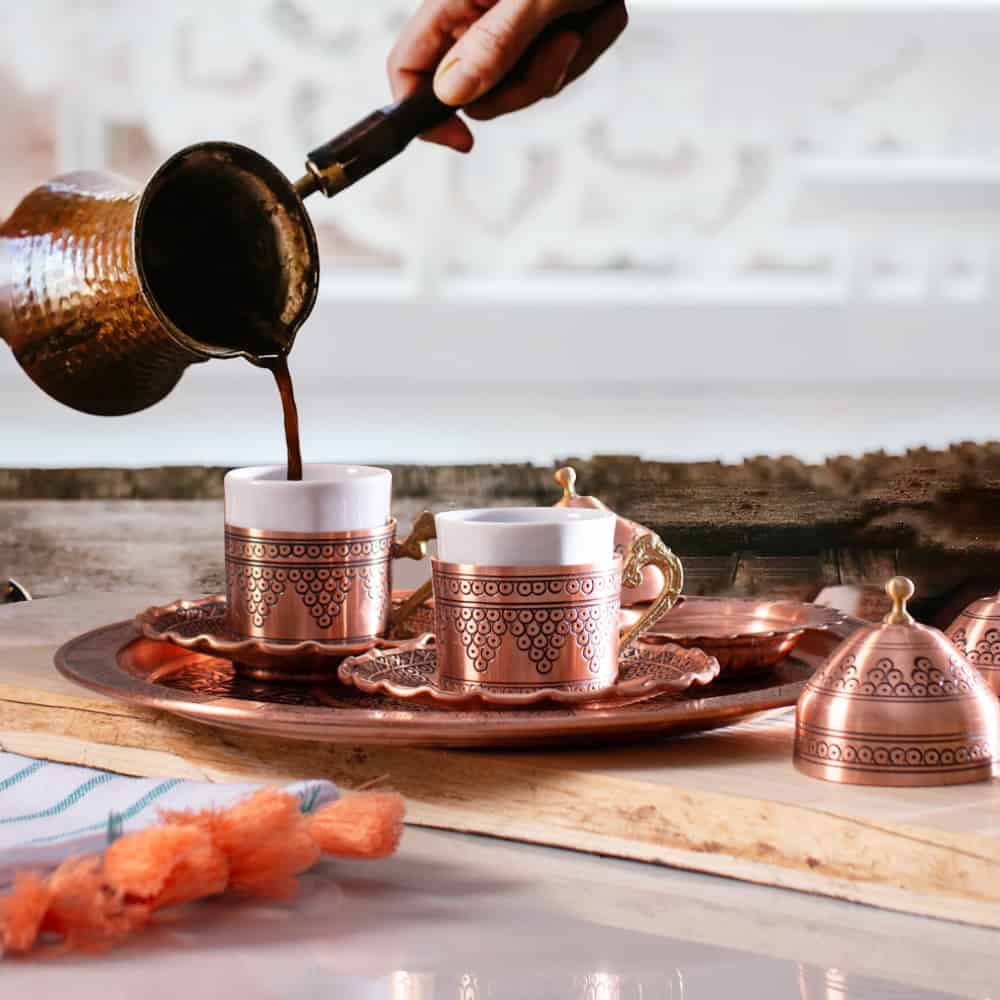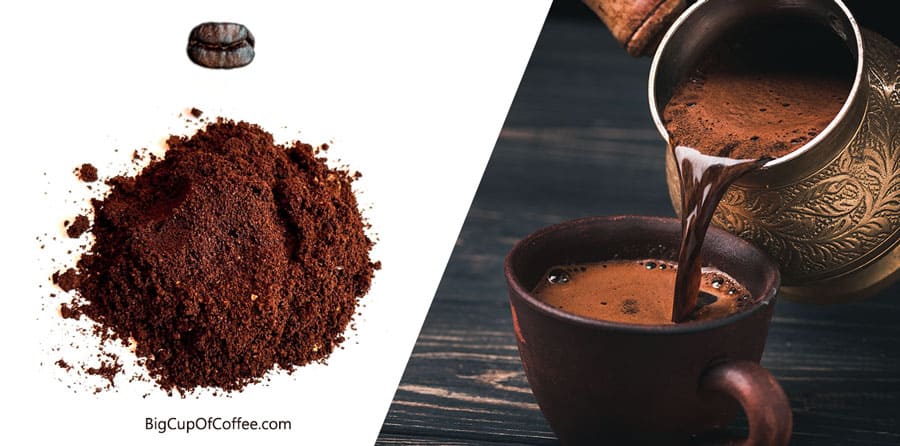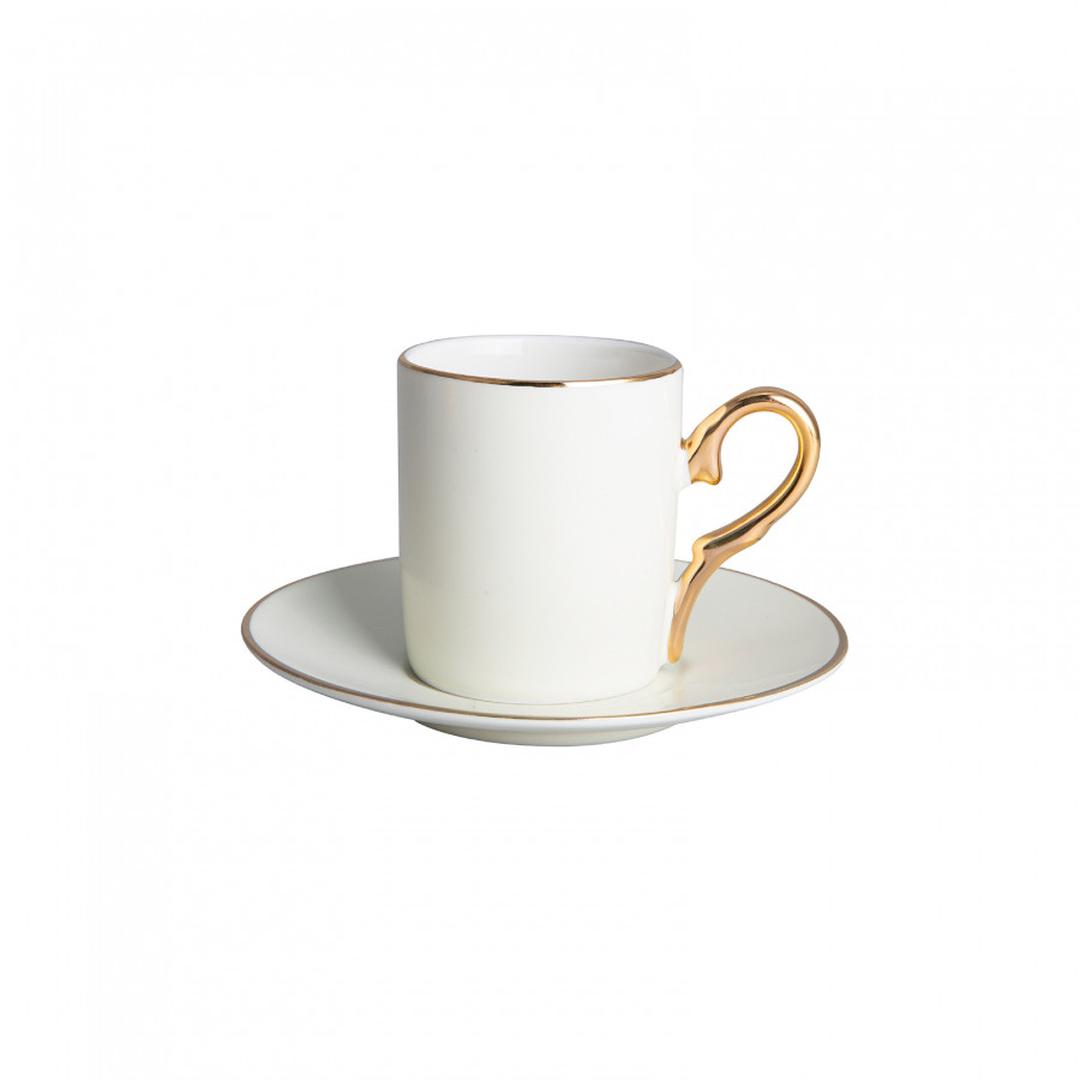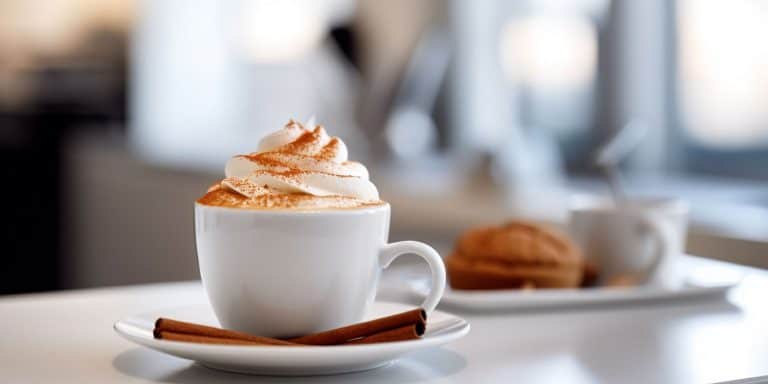Taste History with this Easy to Make Turkish Coffee Recipe
The aroma of a freshly brewed cup of creamy and bold Turkish coffee has been captivating the senses since the 1500s.
And now you can experience this unique flavor in your own home, in under 15 minutes.
I’ve got just the recipe that will have you brewing this unique type of coffee, so get ready – it’s time to learn how make an aromatic and delicious cup of traditional Turkish coffee.
What is Turkish Coffee?
Turkish coffee is traditionally brewed in a copper coffee pot called a cezve/ibrik – a small pot with a long handle. Even though you only need finely ground coffee, water, and probably some sugar, it takes longer to prepare than other coffee types you’re used to.

It is known for its strong, bitter flavor, and slightly sweet aftertaste. The coffee is brewed slowly over low heat, served in small cups, and the grinds left over can even be used to tell your fortune.
Turkish coffee has a rich history, with its origins traced back to the mid-1500s. It quickly became popular within Ottoman society and during this time professional baristas known as “Kahveci Usta” began preparing Turkish Coffee for palace dwellers and high ranking officials throughout the empire. In the 1650’s, however, the Grand Vizier issued laws to shut down the coffee houses due to fears of subversive activities taking place in them.

Today, Turkish Coffee is still seen as an integral part of many cultural traditions including marriage ceremonies where brides prepare special cups of raw ground beans mixed with sugar or salt depending on their intention… Something that will certainly leave both families involved feeling satisfied 😉
What Do You Need to Make Turkish Coffee?
Turkish coffee is traditionally made with only two ingredients:
- coffee
- filtered water
You need to grind your beans extra-fine for Turkish coffee.

That’s all you need. Additionally, you can add aromatic spices and sweeteners to improve the flavor like:
- sugar and cardamom
- cinnamon
- cloves
- nutmeg
- vanilla powder
How to Make Turkish Coffee
There is only one bare-bones way to brew delicious Turkish coffee. You can start by following the quick and easy recipe below.

Taste History with this Easy to Make Turkish Coffee Recipe
Ingredients
- 2 tbsp extra-fine coffee grounds
- 1/2 cup water
- 1 tsp sugar (optional)
- 1/4 tsp spices (optional)
Instructions
- Gather your ingredients.
- Place all these into your metal Cezve (Turkish coffee pot).
- Stir the ingredients a few times, but then don’t stir it anymore while the coffee is brewing.
- Heat it up slowly over medium heat for 3-4 minutes until bubbles start to form at the surface, creating a dark golden froth.
- Transfer 1 teaspoonful of foam to each cup with a spoon.
- At first boil, remove from heat, and pour half of the mixture into your cups.
- Return to heat, and bring to a boil again. Be very careful not to boil too long, otherwise, you’ll over-extract the coffee, and it will be bitter.
- Slowly pour the coffee into your coffee cup at an angle, to keep the froth from collapsing.
- Allow the coffee grinds to settle for about a minute before serving.
Video
Notes
- You can add a quarter teaspoon of spice blends (like cardamom and cinnamon) if you want a modern twist.
- Only stir the coffee once (after you add the coffee to the pot), and never stir it again to let the grinds settle.
- Never take your eyes off the pot once you start to brew your coffee. You should never let it boil over because it will ruin both the taste and the foam.
- A gas stove is better than an electric stove. Electric stoves produce inconsistent heat, which will destroy your coffee.
- Traditionally there are 4 levels of sweetness to Turkish coffee:
– Sade: no sugar
– Az: ¼ teaspoon
– Orta: ½ teaspoon
– Şekerli: 1 teaspoon
What Kind of Cup Should Turkish Coffee Be Served In?
You can use the demitasse serving cup most of the time. They’re perfect for holding strong, concentrated brews like Turkish coffees and espressos.
However, suppose you want a more authentic experience. In that case, you can use the Turkish coffee cup called the “fincan.” They’re thicker than your standard cups (useful to keep it hot longer), handmade, and generally look better because of their unique design.


Tips to Improve Your Traditional Turkish Coffee Brew
- Turkish coffee is often served alongside something sweet like “lokum” (Turkish delight) or chocolates, so make sure to pair it with these desserts.
- Use extra-finely ground coffee beans. Make sure the consistency of the coffee is ground so finely that it resembles flour. Burr grinders do this job well. However, if you don’t have equipment available, a Nutribullet will do the trick.
- Use medium or dark-roast arabica beans.
- Never brew it with milk, or put it anywhere near milk if you’re trying to make authentic Turkish coffee. Turks would scream at you internally if you did.
- For the best Turkish coffee experience, I also recommend cleansing your palate before drinking the coffee.
- Additionally, since it’s so strong, I recommend serving one cup of water to go with your coffee. No matter how delicious this coffee is, you’ll eventually feel overwhelmed by its concentrated taste.
Frequently-Asked-Questions
With just a few ingredients and a bit of patience, you, too, can have a perfect cup of Turkish coffee that can rival coffee shops.
Let me know how your brew went by commenting below!







What a fantastic read. Tom, I’m just wondering if there are any specific health benefits or drawbacks to drinking Turkish coffee given its strong, unfiltered nature? I’m tempted to try it but I’m also a bit health cautious.
I reckon most folks don’t realize how ceremonious Turkish coffee can be. Good on you for highlighting its cultural importance, Tom. For anyone wondering about the correct cup, traditionally, it’s served in a small porcelain cup called a fincan- it’s all part of the ritual to appreciate the coffee’s full flavor.
Tom, your recipe was a lifesaver for my themed dinner party; thank you. I followed your directions to the letter, and the coffee turned out great. Not only did I impress my guests, but I also got to share the interesting history of Turkish coffee with them. Now I have several friends interested in brewing it themselves.
Wow, that sound like it must have been fun, you’re very welcome.
I loved the article, but I’m a bit unclear about the grind size for the beans. Could you specify how fine the coffee grounds need to be for an authentic Turkish coffee? Hoping to get this right before I attempt your recipe.
As I state in the article, you need very fine grinds for this, finer than espresso.
Being of Turkish descent, I grew up with the scent of coffee lingering every morning. Your article brought back so many memories, Tom. Just a little point to add for those trying this at home: the foam on top is as prized as the drink itself, so don’t skip out on that step. It’s where all the robust flavor lurks.
I’ve always been fascinated by the rich cultural traditions tied to foods and drinks, and your article just took me on a journey. The section on the significance of Turkish coffee in marriage ceremonies was utterly captivating. Can’t wait to prepare a cup with the traditional raw ground beans and a hint of sugar – a little taste of history indeed.